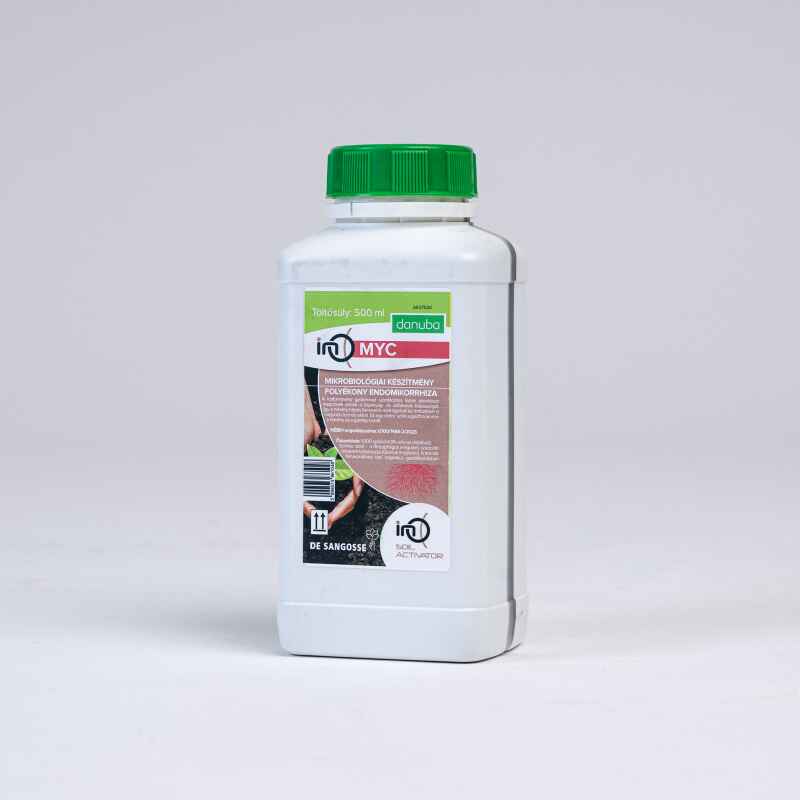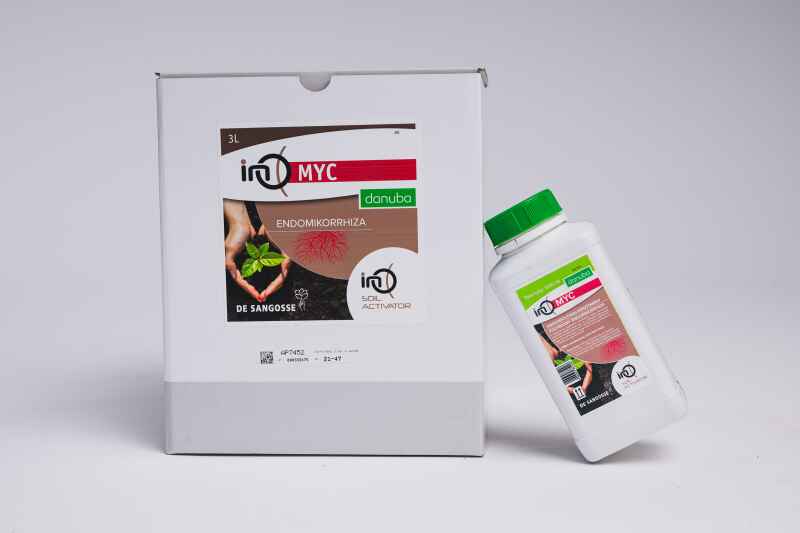Ino Myc 0,5l
| HUF 32,918 * (nettó: HUF 25,920) | |
If you are looking for an approved liquid Micorrhiza on the market with the highest active ingredient, Ino-Myc
Ino Myc contains 1,000 spores in each ml (cm3) and is currently the highest active ingredient of any licensed Microrhiza product on the Hungarian market.Its uniqueness is that it is in liquid form (suspension), which means it is easier to apply e.g. by spraying or liquid adapter.
It is very important that the product may contain a few 10 micron root fragments, so phonon filters should not be used during application!
The product contains endomycorrhizae that will grow into the root of the plant and form a symbiotic relationship with it. Endomycorrhizal fungi are present in more than 90% of the plants grown in our gardens and in agriculture.of the fungi in our soil (called symbiosis).
Under favourable conditions, Ino Myc colonises and symbioses with the root of the host plant in 1-2 weeks. It then helps the crop plant to take up more water and nutrients, boosts the host plant's natural immune system and helps the plant to grow better.and improves soil structure by secreting glomalin proteins that increase the quantity and quality of soil aggregates.
Why is this interaction good for the crop and how is it achieved?
Plants sense when their environment is low in water and nutrients. They then secrete messenger molecules that attract mycorrhizal fungi and encourage them to grow their hyphal filaments into the fresh hair roots of the crop plant. In other words, the plant senses whether it can cope on its own with the task of growing thewater and nutrients in the soil on its own, or it can ask nature for help. If it senses that it needs help, it secretes tracers through its roots into the soil. This signal is sensed by the mycorrhizal fungus and it moves towards the root and then penetrates the root.
If the plant perceives that it can cope with the water and nutrientuptake, it will not secrete any material at all to attract mycorrhizae. If a chemical (non-organic) fertilizer is applied near the root of the plant, it may perceive that symbiosis with the mycorrhizal fungus is not necessary. However, this is deceptive because fertilizers are easily bound to the surface of soil colloids and are then difficult for the plant to take up. Organic manures do not cause this problem.
Why is this relationship good for mycorrhiza?
Mycorrhizae supply nutrients - such as phosphorus for rooting - and water to the plant during symbiosis. It's as if the mycorrhiza supplies a large part of the raw materials to the "kitchen" and in return receives delicious ready meals - sugars, amino acids ... So this symbiosis - mutually beneficial cooperation - is beneficial for both organisms.
What nutrients can mycorrhizae provide to the plant?
It helps the plant to take up all nutrients, but the most important of these is phosphorus. Phosphorus is fixed outside the ideal pH range of 6.5 to 7.5. At higher alkaline pH it forms insoluble compounds with calcium, while in acidic low pH soils it forms insoluble compounds with iron and aluminium. These can be broken up by the mycorrhizal fungus by the hyphae filament and phosphorus can be taken up and transferred to the crop plants. Mycorrhizae also play a very important role in the uptake of microelements and water.
What else is mycorrhiza useful for?
Mycorrhizae, like fungi, once they invade the plant, trigger its natural defence mechanism, as it senses that there is a "fungal attack". However, since mycorrhizae are not dangerous fungi - in fact they are allies - the increased defence does not result in an attack. However, if other fungi or bacteria then try to attack the crop, it has a harder time because of the increased resistance.
Also of great importance is the ability of mycorrhizal fungi to secrete substances - glomalin protein - that help to form soil aggregates. These aggregates are small micro 'clumps' of soil colloids, beneficial fungi and bacteria, nutrients, humic substances, water and calcium, almost glued together. They are extremely important soil components because they contain water and nutrients that are easily absorbed by plants and improve soil structure. You can see this when you pull a plant out of the soil and there are pieces of soil on its roots. Then you have good soil structure.
A recently discovered property of mycorrhizal fungi is their ability to bind plants together. It's like the soil internet. Plants communicate through mycorrhizal fungi and can even transfer nutrients to each other. In the case of trees in forests, mycorrhizal fungi have been shown many times to be usefulas a messenger channel to support weaker species.
Why can mycorrhizal fungi provide more water and nutrients to the crop?
The filament of the mycorrhizal fungus is an order of magnitude thinner than the hair root of the host plant. This allows it to enter places where the crop plant cannot. The fungus also secretes other acids and enzymes that make it able to absorb extra nutrients.
Which plants are colonised more or less by mycorrhizae?
In the case of grapes and fruit, and 90% of the crops we grow, a very strong symbiosis develops. However, some plants are less able to establish a symbiotic relationship with mycorrhizae, such as pig(Amaranthaceae family), such as sugar beet, or Brassicaceae, such as the Brassicaceae family. Brassicaceae such as rape, cabbage, mustard and horseradish.
There are also crops such as. pines, where the hyphal filament of the mycorrhizal fungus does not penetrate the roots of the plant - and creates arbuscules where the exchange/barcell takes place - but only grows around the roots. These latter are the ecto mycorrhizas.
Are all mycorrhizae able to penetrate and symbiose with the host plant?
Only the arbuscular mycorrhizal fungi, the oldest and most widespread type of mycorrhizae, are capable of such contact. The hyphal filaments of these fungi are able to penetrate the cell wall of the plant root's cortical cells. In the root, hyphae can form special formations, called vesicles and arbuscules, which have a storage and surface-enriching role. These symbiotic mycorrhizal fungi are uniformly classified in the phylum Glomeromycota.
Composition
1 000 spores/ml of Rhizophagus irregularis strain DAOM 197198.
Spore suspension.
Uses:
Dose:
Cost per hectare:
Warranty:
Storage:
Packaging:
pH:
Density:
Recommended use
Two uses are possible:
- when sowing, planting or transplanting the plant, apply close to it. The hyphal filament of the fungus from the spore senses the root and is able to grow towards it, but only a few centimetres. Dilute with good quality water to make it easier to distribute the fungal spores evenly
- another possible use is for banding, as it can survive on the surface of the seed for several months. This is due to the fact that the spore will only sprout when it senses that it is in the soil and there is a living root nearby.
| Weight: | 1 kg |
|---|---|
| Aviability: | 1-4 nap |
| Basic sales unit: | db |
| Culture: | Dísznövény, Gyümölcs, Pázsit, Szőlő, Zöldség |
Login
Login

